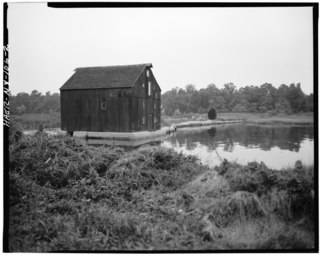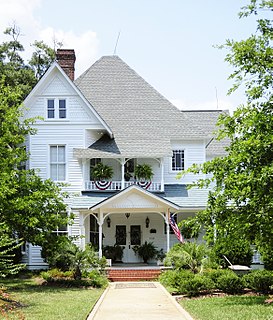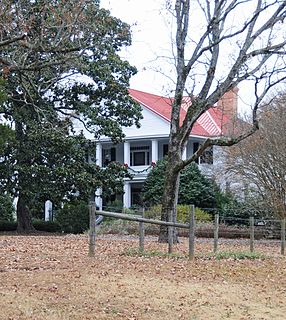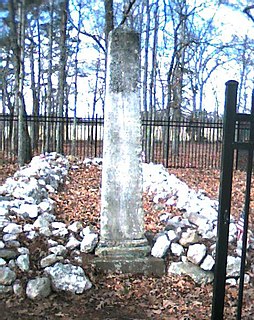
Kershaw County is a county located in the U.S. state of South Carolina. As of the 2020 census, its population was 65,403, up from 61,697 in 2010. The county seat and largest city is Camden. The county was created in 1791 from parts of Claremont, Lancaster, Fairfield, and Richland counties. It is named for Col. Joseph Kershaw (1727–1791), an early settler and American Revolutionary War patriot.

Fort Mill, also known as Fort Mill Township, is a town in York County, South Carolina, United States. It is a suburb of Charlotte, North Carolina. As of 2019, approximately 22,284 people live inside the town's corporate limits. Some businesses and residents in the Indian Land community of neighboring Lancaster County share a Fort Mill mailing address, but the official town boundary extends only within York County.

The Van Wyck Homestead Museum or Van Wyck-Wharton House is an early 18th-century Dutch colonial house in the Town of Fishkill, New York, United States of America. It served as a headquarters to a major military supply depot during the American Revolutionary War and has been listed on the National Register of Historic Places since April 13, 1972; the adjoining Fishkill Supply Depot Site has been listed on the NRHP since January 21, 1974. It is located on US 9 just south of Interstate 84. Excavations during the construction of a nearby gas station and the Dutchess Mall in the early 1970s unearthed many artifacts at the site, particularly materiel.

Indian Land is an unincorporated community in the northernmost part of Lancaster County, South Carolina, United States. It lies east of Fort Mill, just south of Ballantyne in southern Charlotte, and west of the villages of Marvin and Waxhaw in North Carolina.
Van Wyck is a town in the panhandle of Lancaster County, South Carolina, United States. It is part of the Charlotte Metropolitan Area. Van Wyck is 29 miles (47 km) south of Charlotte.

Van Wyck-Lefferts Tide Mill is a historic tide mill located at Lloyd Harbor in Suffolk County, New York. It was built about 1793 and is a 3+1⁄2-story, gable-roofed, timber-framed rectangular building little altered since the early 19th century. The property also includes the earthen mill dam with sluice gates. The Nature Conservancy, which owns the mill, offers free boat tours to the site from May through October.

Waxhaw Presbyterian Church Cemetery, also known as Old Waxhaw Cemetery, is a historic Presbyterian church cemetery located near Lancaster, Lancaster County, South Carolina. It was founded in 1757 and is a visual reminder of the pioneer settlement of Waxhaw. It includes noteworthy examples of 18th and 19th century tombstones.

The Cornelius Van Wyck House is an 18th-century Dutch Colonial home located on the shore of Little Neck Bay in the Douglaston section of Queens in New York City. This house overlooks Little Neck Bay and is well known for both its age and architecture, and especially for its original owners. It was designated as a landmark by the New York City Landmarks Preservation Commission in 1966 and added to the National Register of Historic Places in 1983. The Cornelius Van Wyck House is considered to be the "most impressive architectural remnant of the early Dutch Culture" in New York.

Robert Barnwell Allison House is a historic home located at Lancaster, Lancaster County, South Carolina. It was built in 1897, and is a rectangular, two-story, frame clapboard covered Queen Anne style dwelling. It has a tall, hipped roof with intersecting gables and diamond novelty shingle covered gable ends.

Cureton House is a historic home located near Lancaster, Lancaster County, South Carolina. It was built about 1840, and is a two-story, L-shaped, frame Greek Revival style residence. It is sheathed in clapboard siding and has cross-gable roof and brick pier foundation. The house has a central hall plan and two rooms in the rear ell. Also on the property is a cotton storage shed, barn, and garage.

Leroy Springs House, also known as Lancaster City Hall, is a historic home located at Lancaster, Lancaster County, South Carolina. The original section was built in 1820–30. The house was greatly enlarged in the mid-1850s and it took its present appearance in a 1906-07 remodeling. It is a two-story, frame residence. The façade features a two-tiered pedimented portico defined by fluted columns with Doric order-influenced capitals. The building was converted to municipal use as a city hall in 1957.

Wade-Beckham House, also known as Beckham House, is a historic home located near Lancaster, Lancaster County, South Carolina. It was built ca 1832 and is a two-story frame residence, in a blend of Greek Revival and Neo-Classical styles. Originally one room deep, the structure was doubled in size in 1916. The original porch on the front remains basically intact. A one-story kitchen wing and porch on the rear of the structure were part of the 1916 addition. Also on the property are a contributing small wooden store and a barn.

William Harrison Sapp House is a historic home located near Tradesville, Lancaster County, South Carolina. It was built about 1897, and extensively remodeled in 1912. It is a two-story Colonial Revival style frame residence with a one-story rear projection. It features a one-story hipped-roof wraparound porch, supported by Tuscan order columns. A small one-story gable-front frame drug store/office built in 1912, is located on the property. Dr. William Harrison Sapp (1866-1946), was a prominent local physician and farmer.
Adam Ivy House is a historic home located near Van Wyck, Lancaster County, South Carolina. It was built about 1849–1850, and is a two-story, vernacular Greek Revival style frame dwelling. It has a full-width, one-story front porch. Additions and renovations took place around 1920. Also on the property are two contributing outbuildings; large and small barns located near the house.

Perry-McIlwain-McDow House, also known as Fairview Farm, is a historic home located near Lancaster, Lancaster County, South Carolina. It was built about 1840, and is a 1+1⁄2-story, Greek Revival raised cottage. It has a temple-front classical portico containing a recessed porch with balustrade.

North Carolina-South Carolina Cornerstone is a historic boundary marker located near Lancaster, Lancaster County, South Carolina. It was erected in 1813, and is located on the boundary between Lancaster County, South Carolina and Union County, North Carolina. The cornerstone was erected by commissioners appointed by the two states to survey the boundary between the western termination of the boundary line which had been run in 1764 and to the southeast corner of Catawba lands. The cornerstone is an uneven, rectangular, upright metamorphosed igneous stone marker approximately two feet high. The top part of the cornerstone, which contains the engraved notations, "N.C." and "S.C." was broken off when a car hit the marker in 1977. On the portion of the stone remaining at the original site can be seen "A.D. 1818."

Buford's Massacre Site, also known as Buford's Battleground, is a historic site and national historic district located near Lancaster, Lancaster County, South Carolina. Two monuments now mark the Buford Battleground. A white monument ten feet tall, erected on June 2, 1860, marked the American gravesite. This marker became so scarred from chippings of souvenir hunters that a new monument was erected on May 1, 1955, bearing the same inscription. Buford's Massacre was one of the many vicious actions that characterized the Revolutionary War campaigns in the backcountry South. This particular battle became a symbol of British atrocities and Banastre Tarleton became known as “Bloody Tarleton.”

Matson Street Historic District is a national historic district located at Kershaw, Lancaster County, South Carolina. It encompasses 26 contributing buildings in a residential section of Kershaw. The majority of the buildings date from about 1890 to 1940, a particularly significant period of development in Kershaw. The houses are in a variety of representative architectural styles include Victorian, Queen Anne, Bungalow, American Craftsman, Colonial Revival, and Neo-Classical. Also located in the district is the First Presbyterian Church.

Lancaster Downtown Historic District is a national historic district located at Lancaster, Lancaster County, South Carolina. It encompasses 12 contributing commercial buildings in central business district of Lancaster. The buildings date from about 1880 to 1935. It is the most intact section of Lancaster's early business area. Notable building include the United States Post Office, the Springs Block, the Farmers’ Bank and Trust Company Building, and the Bank of Lancaster/Opera House.

Thomas Fraser House, also known as Woodham House and Gregg House, is a historic home located at Bishopville, Lee County, South Carolina. It was built in 1847, and is a two-story, vernacular Greek Revival style house with a gable roof, weatherboard siding and a brick foundation. The front façade features a one-story porch supported by six round brick and stucco columns with prominent bases and Doric order capitals. At the rear of the house is the original kitchen, remodeled about 1900 into a farm office.






















